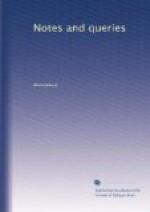I have not been able to find the Sapcote motto on record; and I believe the Carysfoot family, the possessors of Elton, and the Duke of Bedford, the heir in blood, to be ignorant of what this scroll is intended to represent.
Erminois.
Athenaeum Club.
Scala Coeli.—In a will, dated 12 Hen. VIII., the testator directs that there shall be four trentals of Saint Gregory said for his soul at London at “Scala Coeli.” Can any of your readers explain what place is meant by “Scala Coeli?”
A Subscriber.
Illustrations of Gresset’s “Vert Vert,” painted on Enamel, &c.—In a Paris edition of Gresset’s Works (Janet et Cotelle, 1823), in the preface is the following passage.—
“Vert-vert fut bientot dans toutes les mains. Le suffrage de la multitude se joignit a celui des connoisseurs; la mode, qui est aussi en possession de donner son suffrage, s’empressa de parer les ajustemens d’invention recente, du nom de l’illustre perroquet; les vases d’ornement, les vases usuels qui sortoient des fabriques francoises, retracoient presque tous quelques episodes du petit poeme. Un artist dont le nom est venu jusqu’a nous, Raux, en peignit sur email les sujets les plus marquants; et tandis qu’on faisoit passer dans une version latine les vers elegants du poete jesuite, M. Bertin, ministre d’etat, le gratifioit d’un magnifique cabaret de Sevres, dont toutes les pieces reproduisoient les aventures de son heros, ce qui fit dire a Gresset, qu’on le traduisoit aussi en porcelaine de Sevres.” {367}
The Query I wish to make is, Have any of these illustrations or designs from Gresset’s poem of Vert-vert, painted on enamel china, or earthenware of any sort, of French or any other manufacture, come to light of late years? or more lately still, among the articles that have been dispersed among various buyers of almost all nations, in the sales within these few weeks effected at Paris?
Robert Snow.
Urbanus Regius.—A friend of mine, a delightful old lady, fresh, genial, and inquisitive, has in her possession an old volume, a family heir-loom, which is not the less dear to her for being somewhat dingy and dilapidated, and touching which she would gladly receive such information as your correspondents can supply.
It is made up of three apparently distinct treatises; the first (of which several leaves are wanting) on the twelve articles of the Apostles’ Creed. The second is “The ryght foundation, and pryncypall common places of the hole godly Scripture,” &c., by Doctor Urbanus Regius. Prefixed is an epistle to Thomas, Archbishop of Canterbury (evidently Cranmer), to whom “Hys dayly oratoure, Gwalter Lynne (the writer of the epistle), wyssheth lyfe euerlastynge.” Between this second treatise and the third, and apparently belonging to the latter, is a title-page with the following inscription:




